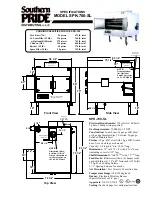
OTHER THINGS YOU CAN DO TO MAKE YOUR
FAMILY AND HOME SAFER FROM FIRES
Installing, testing and taking care of smoke alarms is just one step in helping
to protect your family and home from fires. You also must reduce the chance
that fire will start in your home and increase your chances of escaping if one
does start. For your safety, at a minimum, you should do the following to
have a more effective fire safety program.
A. FOLLOW SAFETY RULES AND PREVENT HAZARDOUS SITUATIONS
• Use smoking materials properly-never smoke in bed or when sleepy or
under the influence of alcohol or other drugs.
• Keep matches and other fire starters away from children.
• Store flammable materials in proper containers and never store or use
them near open flames or sparks.
• Keep electrical appliances and cords in good working condition, and do
not overload electrical circuits.
• Keep stoves, fireplaces, chimneys and barbecue grills clean and make
sure they are properly installed away from combustible materials.
• Keep portable heaters and open flames such as candles away from
combustible materials.
• Do not allow rubbish to accumulate.
B. DEVELOP A FAMILY ESCAPE PLAN AND PRACTICE IT REGULARLY WITH
YOUR ENTIRE FAMILY ESPECIALLY SMALL CHILDREN
• Draw a floor plan of your home and find TWO ways to exit from each
room. There should be a way to got out of each bedroom without opening
the door.
• Teach children what the smoke alarm signal means, and that they must
be ready to leave the home or residence by themselves if necessary.
Show them how to check to see if doors are hot before opening them,
how to stay close to the floor and crawl, and how to use the alternate
exit if a door is hot and should not be opened.
• Decide on a meeting place a safe distance from your house and make
sure all your children understand they should go and wait for you there
if there is a fire.
• Hold fire drills every six (6) months to make sure everyone, even small
children, know what to do to escape safely.
• Know where to go to call the fire department from outside your residence.
• Provide emergency equipment, such as fire extinguishers, and teach
your family how and when to use this equipment.
C. WHAT TO DO IF THERE IS A FIRE IN YOUR HOME
After you have prepared family escape plans and practiced them with your
family, you have increased their chances of escaping safely. Review the
following rules with your children when you have fire drills so everyone will
remember them in a real smoke or fire emergency.
• Don’t panic; stay calm. Your safe escape may depend on thinking clearly
and remembering what you have practiced.
• Get out of the house following your planned escape route as quickly as
possible. Do not stop to collect anything or to get dressed.
• Open doors carefully only after feeling to see if they are hot. Do not
open a door if it is hot; use an alternate escape route.
• Stay close to the floor; smoke and hot gases rise toward the ceiling.
• Keep doors and windows closed unless you open them to escape and
reclose them as you leave.
• Meet at your prearranged meeting place after leaving the house.
• Call the fire department as soon as possible from outside your house.
Give the address and your name.
• Never re-enter a burning or smoke-filled building.
Contact your local fire department for more information on making your home
safer from fires and about preparing your family’s escape plans.
110-657D 12/9/05 2:39 PM Page 7






























